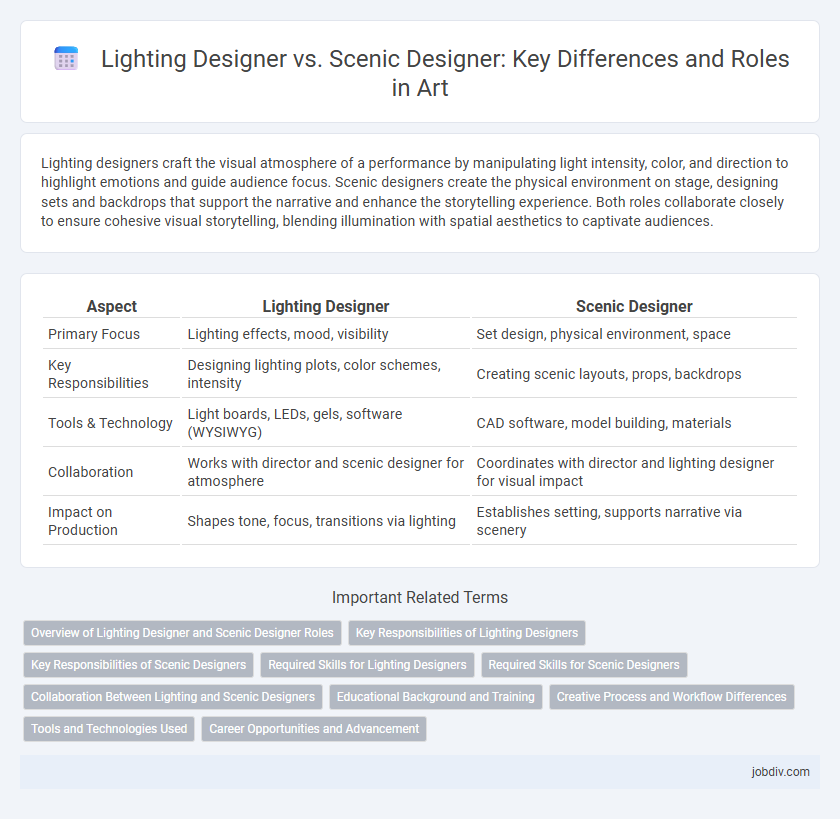Lighting designers craft the visual atmosphere of a performance by manipulating light intensity, color, and direction to highlight emotions and guide audience focus. Scenic designers create the physical environment on stage, designing sets and backdrops that support the narrative and enhance the storytelling experience. Both roles collaborate closely to ensure cohesive visual storytelling, blending illumination with spatial aesthetics to captivate audiences.
Table of Comparison
| Aspect | Lighting Designer | Scenic Designer |
|---|---|---|
| Primary Focus | Lighting effects, mood, visibility | Set design, physical environment, space |
| Key Responsibilities | Designing lighting plots, color schemes, intensity | Creating scenic layouts, props, backdrops |
| Tools & Technology | Light boards, LEDs, gels, software (WYSIWYG) | CAD software, model building, materials |
| Collaboration | Works with director and scenic designer for atmosphere | Coordinates with director and lighting designer for visual impact |
| Impact on Production | Shapes tone, focus, transitions via lighting | Establishes setting, supports narrative via scenery |
Overview of Lighting Designer and Scenic Designer Roles
Lighting designers focus on creating atmosphere and mood through strategic use of light, color, and intensity, enhancing the narrative and visual impact of a production. Scenic designers develop the physical environment of a stage, crafting sets, backdrops, and props that establish the setting and support the story's themes. Both roles collaborate closely with directors and production teams to ensure cohesive aesthetics and seamless integration of visual elements.
Key Responsibilities of Lighting Designers
Lighting designers specialize in crafting the visual atmosphere of a stage production through strategic placement and manipulation of light sources, enhancing mood, focus, and spatial perception. They collaborate closely with scenic designers to complement set elements while meticulously programming lighting cues and effects to support narrative flow and actor visibility. Expertise in color theory, light intensity, timing, and technological proficiency with lighting instruments and control consoles are fundamental to effective lighting design.
Key Responsibilities of Scenic Designers
Scenic designers are responsible for creating the visual environment of a theatrical production, including the design and construction of sets, props, and backdrops that support storytelling. They collaborate closely with directors and lighting designers to ensure cohesive aesthetics and functional stage elements. Their expertise includes drafting detailed blueprints, selecting materials, and overseeing the scenic painting and installation processes.
Required Skills for Lighting Designers
Lighting designers require expertise in color theory, electrical systems, and programming lighting consoles to create visually compelling stage environments. Mastery of software such as Vectorworks Spotlight and AutoCAD is essential for drafting precise lighting plots and integrating fixtures with scenic elements. Strong collaboration skills and an understanding of scene transitions enhance the seamless synchronization of lighting cues with performance dynamics.
Required Skills for Scenic Designers
Scenic designers must possess strong spatial awareness and proficiency in drafting software such as AutoCAD or SketchUp to create detailed and accurate set designs. Expertise in color theory, materials, and construction techniques ensures their designs are both visually compelling and feasible for stage production. Collaboration skills are essential for working with directors, lighting designers, and production teams to bring cohesive and immersive environments to life.
Collaboration Between Lighting and Scenic Designers
Lighting designers and scenic designers collaborate closely to create immersive theatrical environments by integrating light, color, texture, and spatial elements. Effective communication ensures that lighting enhances scenic design features, emphasizing mood, depth, and atmosphere without overshadowing physical sets. This teamwork elevates stage aesthetics, harmonizing visual components to support storytelling in live performances.
Educational Background and Training
Lighting designers typically pursue degrees in theatrical design, often specializing in lighting or technical theatre, emphasizing courses in electrical engineering, color theory, and lighting technology. Scenic designers generally hold degrees in scenic or set design, fine arts, or theatre production, focusing on drawing, model building, and spatial design. Both disciplines require hands-on training through internships, workshops, and collaborations with theatre companies to master the practical application of their craft.
Creative Process and Workflow Differences
Lighting designers focus on manipulating light intensity, color, and direction to enhance mood and highlight key elements within a scene, using specialized software like Vectorworks or WYSIWYG for precise plotting and cue programming. Scenic designers develop physical environments and set pieces that shape the narrative's spatial context, employing tools such as AutoCAD and hand-drawn sketches to create detailed models and renderings. The lighting design workflow heavily revolves around collaboration with directors and electricians to adjust cues during rehearsals, whereas scenic design requires early-stage conceptualization and integration with construction teams to bring tangible sets to life before technical rehearsals begin.
Tools and Technologies Used
Lighting designers utilize advanced lighting consoles, LED fixtures, DMX controllers, and software like Lightwright and Vectorworks Spotlight to craft dynamic illumination and mood on stage. Scenic designers employ CAD programs, 3D modeling software such as SketchUp or AutoCAD, and traditional tools like drafting tables and physical model materials to create immersive set designs. Both roles increasingly integrate virtual reality and augmented reality technologies to visualize and adjust their designs before production.
Career Opportunities and Advancement
Lighting designers specialize in creating visual atmospheres through light, offering career opportunities in theater, film, television, and live events, with potential advancement to lead designer or art director roles. Scenic designers focus on crafting physical environments and stage settings, often advancing to production designer or creative director positions within theater, film, and television industries. Both careers require strong collaboration skills and offer upward mobility through experience, portfolio development, and networking within the entertainment sector.
Lighting Designer vs Scenic Designer Infographic

 jobdiv.com
jobdiv.com